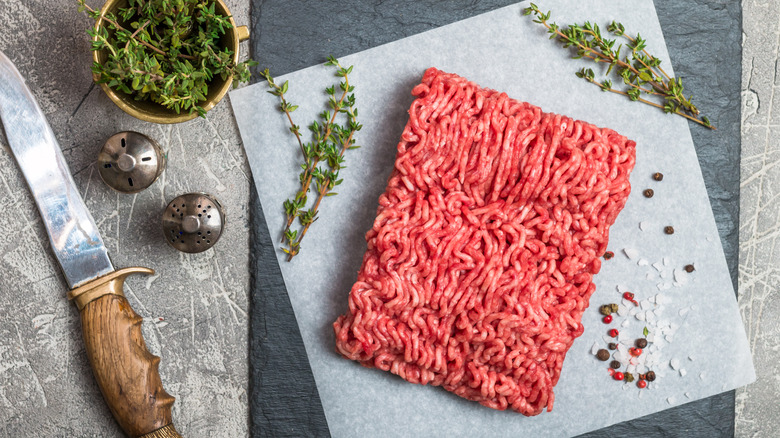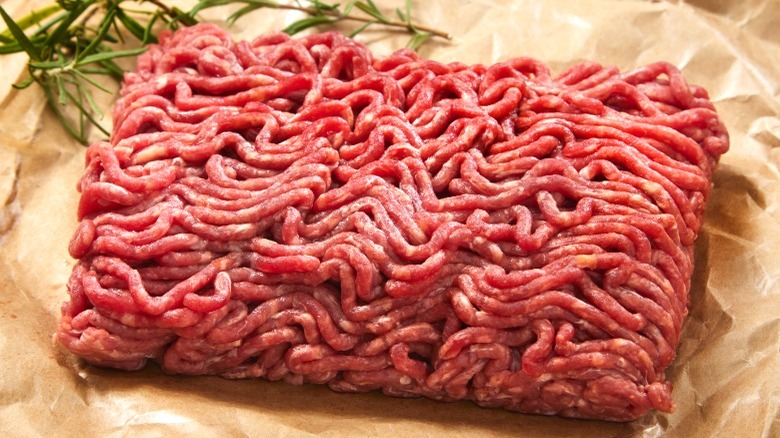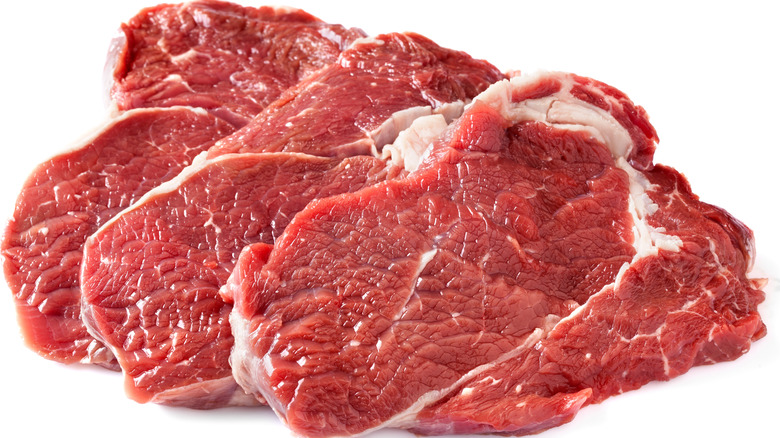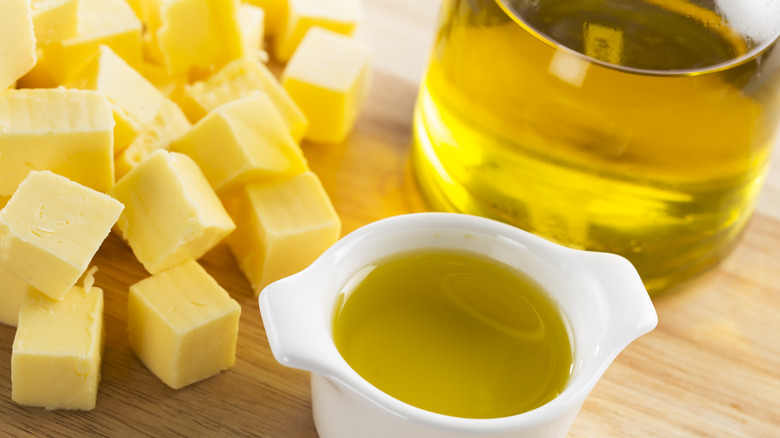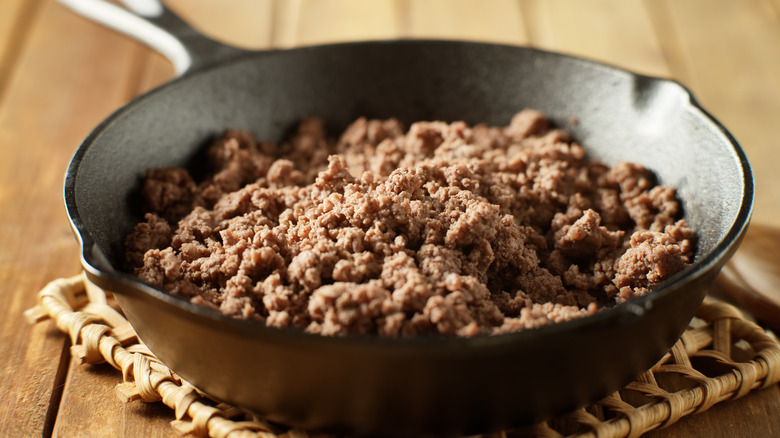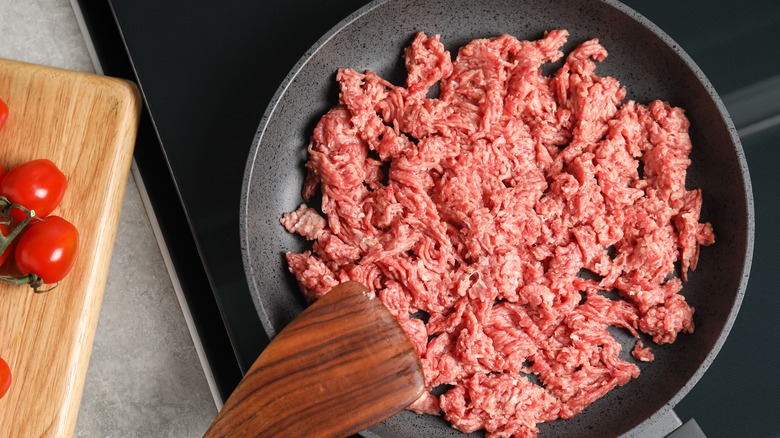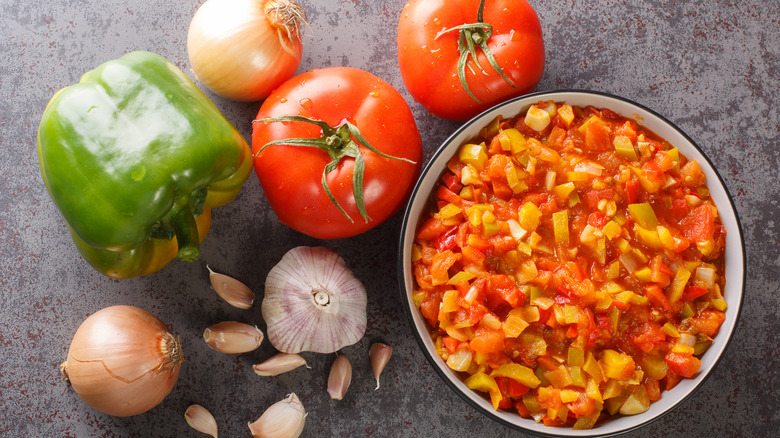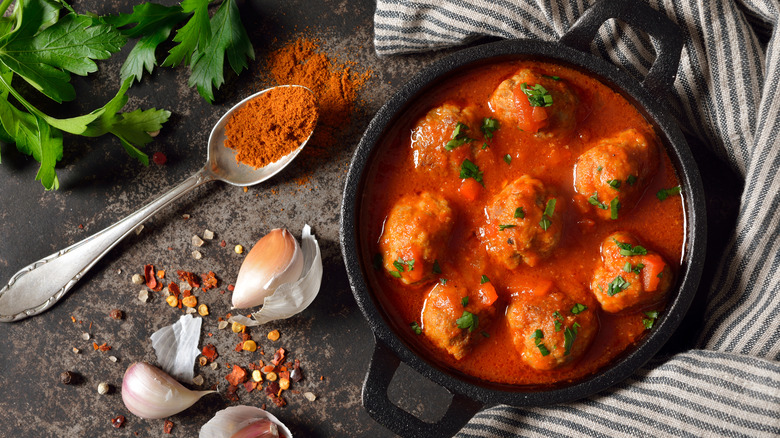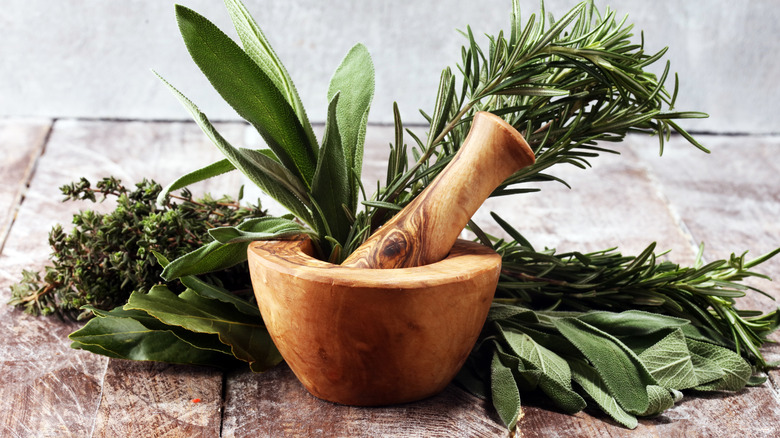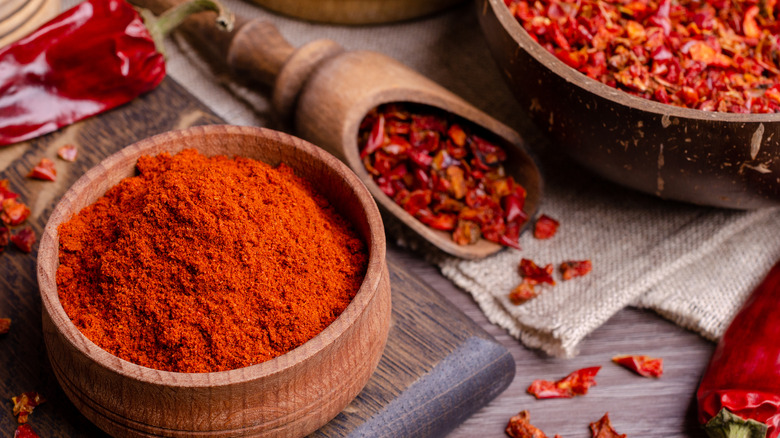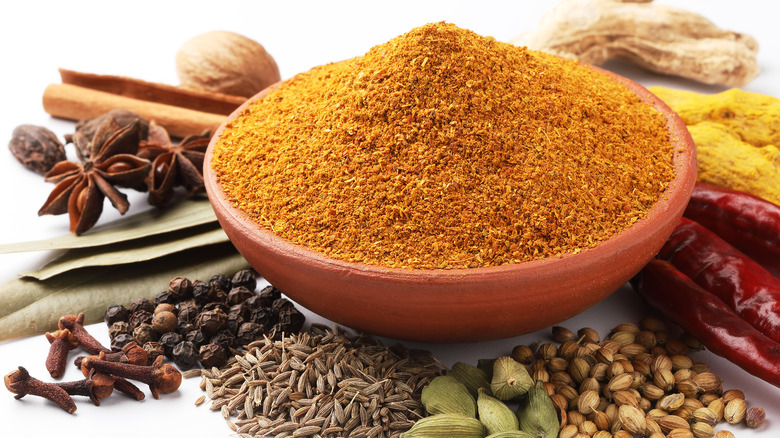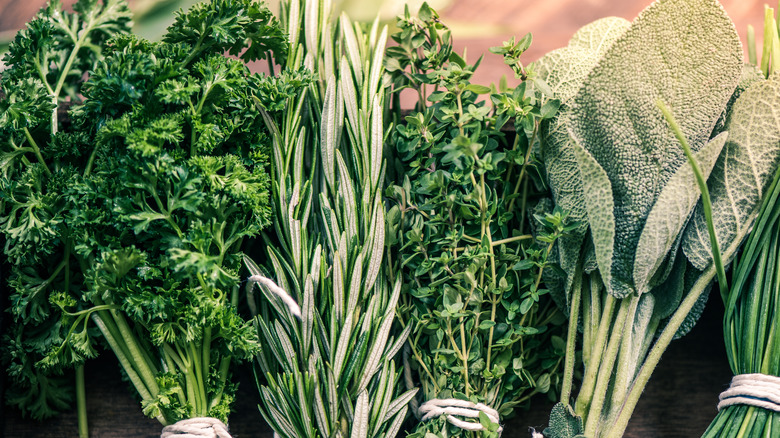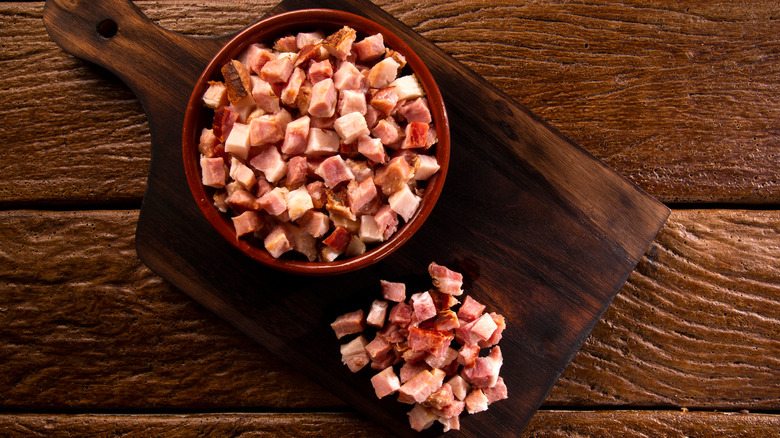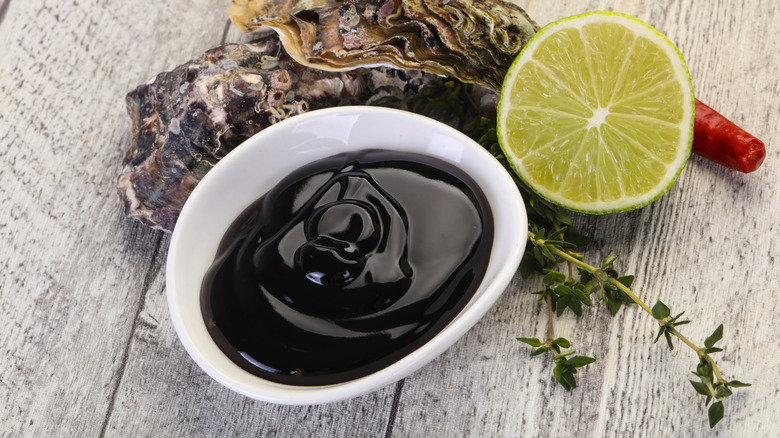13 Ways To Add Flavor When Cooking Ground Beef
Ground beef may not sound as high-end as prime rib, but ground beef is one of the most versatile meat options that can be included in an array of culinary dishes. With a multitude of ways to add flavor when cooking ground beef, this minced meat doesn't often get the praise it should. And it should because ground beef makes up the starring role in many comforting dishes, whether it's the main contender in a double, bacon cheeseburger or a complement to other hearty meats, such as ground pork or lamb, mixed up into a timeless meatloaf.
Typically comprised of beef trimmings from primal cuts, ground beef has long been a go-to for many households and a consistent best-selling beef product. Cooking with ground beef gives you the opportunity to create an incredible range of tasty meals in your kitchen, like loaded beef enchiladas or a classic American chop suey. From choosing a high-quality minced beef blend to seasoning for various regional cuisines, we put together many ways to add flavor when cooking ground beef.
1. Source high quality beef
One of the top ways to boost flavor when cooking ground beef is to start with the best source. Getting your meat directly from a regenerative farm or a local butcher brings you a few steps closer to freshness. Good for ranchers and better for the environment, regenerative farming helps restore the soil and vegetation, contributing to a thriving ecosystem. Cows get to graze on a lush pasture and ranchers get to give back to the earth. In return comes high-quality cattle.
Beef cuts are labeled in various grades. The three main grades — prime, choice, and select, are determined by the age and fat level of the meat. Prime is the best and features the highest fat content, witnessed in the heavy marbling throughout the cut. Prime is a highly sought-after grade, but choice is the most popular grade picked by consumers. And understandably so, choice cuts are tender when cooked correctly and have a hearty beefiness that works well with many ingredients.
2. Consider the lean-to-fat ratio necessary for the recipe
Choice cuts, such as chuck, round, and sirloin, are the first to become ground beef and are sold in percentages of leanness, typically from 70% to 93%. That is, the frequently seen 80% lean ground beef prepackaged at the grocery store provides 20% fat. And though ground beef can come from any part of the cow, ground beef made from chuck is the most popular type of specified ground beef. But you can ask a butcher to grind up any cut you desire to create your own minced mixture.
Though 80% ground chuck is the favored ground beef mixture, it's important to pay attention to the particular cut, grade, and lean percentage of the ground beef your recipe calls for. Fattier beef like 70% carries more flavor and moisture, makes juicy burgers and moist meatloaf, but may need to be drained if you choose to brown it in a pan as beefy crumbles. Leaner ground beef such as 90% is better suited for dishes that center around a broth, sauce, or stew base. It's also a good option if you're mixing it with a fattier protein like ground pork for hamburgers, meatballs, or meatloaf.
3. Brown the meat with additional fat
Though ground burger is already fatty, and you don't technically need to add more, fats such as butter, olive oil, and lard (especially from smoked bacon), enhance beef for just about any style of dish. Your recipe may recommend a fat for browning but there is often enough wiggle room in the recipe to experiment with another variety. But it's not just the flavor profile of a recipe that determines what fat you cook ground beef with, smoke point matters, too. The addition of fat contributes to browning the ground beef properly, which is done over high heat, enhancing the rich taste of the meat through the Maillard reaction.
To achieve a crispy sear on the outside of your ground burger, choose an oil with a high smoke point, such as olive, coconut, or avocado oil. Each carries its own taste that can add a nice underlying current to your final dish. Butter features a lower smoke point and requires a lower cooking temperature so it doesn't burn. It's still good for cooking minced meat but you may not get the same caramelized sear as you would using a higher heat. However, butter lends a rich and creamy, maybe sweet and tangy, bite to your burger. For the best of both worlds, sear ground beef over high heat with a high-smoke-point oil and finish cooking it over medium heat using butter.
4. Use a cast iron skillet for a flame-grilled taste
It's hard to talk about cooking meat without talking about cast iron pans. Coveted by many cooks and feared by others, the cast iron pan works a little differently than your standard stainless steel or nonstick pan. From treating and seasoning to using and maintaining a cast iron skillet, it may seem overwhelming but it's not more difficult to use than any other pan.
Give your ground beef the umami of a flame-grilled burger, whether as crumbles, patties, or meatballs. Through high heat, a cast iron pan helps deliver a superior exterior crust while imparting an authentic flame-grilled taste. For crumbles, sear your overall portion of ground beef, intact before you break it up, in a pan over medium or high heat with your chosen fat or oil. Following the general guidelines of searing meat, brown the packed ground beef on both sides for a few minutes each before you break it up into crumbles to finish cooking. Take it one step further and create a one-pan meal after searing your ground beef.
5. Do not overcrowd your pan when browning
With a wide range of claims over the best way to brown ground beef crumbles, a wise step in the process is to separate the beef mixture evenly in the pan to avoid overcrowding the meat as it cooks. Sear the ground beef as a chunk of meat at the start of cooking to get the initial sear, but break it up in the pan afterward. Leave enough room among the beef crumbles so that the steam evaporates, allowing for a continuation of the Maillard reaction.
The Maillard reaction is the result of a reducing sugar interacting with an amino acid because of high heat. What this means for your ground beef is a surplus of flavor compounds are released in the meat, providing additional layers of savoriness. You don't want to over-mix your ground beef as it's cooking (because this will interrupt the searing action), so continue to break up larger chunks to encourage browning across more of the ground beef. Spreading out the ground beef also enables you to season the meat well without leaving bland pockets behind.
6. Create a flavor foundation that complements your recipe
One way to add flavor when cooking ground beef is to develop a flavor foundation. If you're cooking with a recipe, chances are the foundational seasonings are written in. The foundation is the underlying base seasonings that set the stage for the accompanying ingredients, which leads to the tone of the dish. Specific flavor foundations are an automatic go-to in many regional cuisines for a range of recipes, particularly when sautéing or braising anything in a skillet.
Referred to as sofrito, or soffritto in Latin and Italian cuisines, mirepoix in French recipes, or holy trinity in Cajun cooking, a flavor foundation consisting of chopped vegetables, herbs, and spices. The specific ingredients used depend on which cuisine you're fixing. Base elements are usually composed of diced onion, carrot, bell pepper, celery, and garlic.
Sear your ground beef in fat, scoop out the cooked burger with a slotted spoon, and put it aside to add back to the pot later. Cook the sofrito and then reintroduce the ground beef back into the pan. Alternatively, cook your mirepoix first and then add your minced meat to cook alongside the other ingredients. You're unlikely to get a crispy sear on your beef but you'll certainly achieve extra savoriness.
7. Braise or simmer the ground beef
Braising ground beef may seem odd, but ground meat made from a tougher cut or into meatballs can benefit from this way of cooking. Braising and simmering cooks food in a shallow liquid bath over low heat for extended periods of time. But different than simmering, braising calls for browning the ground beef first. The browned meat contributes an intense layer of beefiness to the braising liquid that enhances the overall outcome of your dish. If you want to skip this step and aren't searching for that deep umami touch, simmering works well, too, especially for recipes that feature a liquid base or savory gravy.
Liquids frequently used for braising meat include water, stock or broth, wine or beer, tomato sauce, and milk or cream. All good options but you may not want to braise your beef in tomato sauce if you're cooking the ground beef for a delicate white sauce. But more important than what braising liquid you choose is how much you use. Aim for ½ to ¾ of the ground beef to be submerged in liquid. Any more than that and it's stew, any less and you're sautéing it instead.
8. Use Italian seasonings
A simple but often overlooked step when preparing a dish is layering the ingredients in order to build the recipe to its fullest potential. It may seem overly obvious, but add Italian seasonings, such as oregano, basil, parsley, marjoram, bay, rosemary, thyme, or sage to your ground beef any time you're creating a dish with an Italian profile. Often used in conjunction with soffritto, these complementary ingredients are an easy way to provide additional hints of Italian aromatics to your ground beef dish.
This layering of ingredients is especially important when making Bolognese sauce — a timeless, meaty Italian sauce where the cook invests time and effort, along with just the right ingredients. Adding Italian seasonings to your ground beef doesn't just help boost the taste of the meat, it also harmonizes with the accompanying sauce. For example, this classic ragu alla Bolognese features sage, bay, and thyme, with other ingredients such as soffritto, white wine, tomatoes, and Parmesan. Also, these special Italian meatballs are layered with oregano and parsley, along with cheese and onion. Rounding out the multifaceted recipe is a tomato-based sauce partnered together with red wine, basil, and pancetta.
9. Season ground beef with peppery spices
Featured, and often the bold highlight, in a number of regional cuisines, hot peppery spices have a way of tap dancing on your taste buds, beckoning you to take just one more bite. So what better way to add flavor when cooking ground beef than seasoning it with a touch (or more for those who need a real kick) of tangy heat?
From the sharp bite of black pepper to the sultry heat of chili peppers, transform your ground beef as part of taco Tuesdays, fajita Fridays, or for a Sunday dinner of jambalaya. The main players include chili peppers, crushed red pepper, black pepper, jalapeño peppers, paprika, poblano peppers, and spicy non-pepper seasonings, such as garlic, onion, and cumin.
Ultimately, what pepper seasoning and how much of each you use is up to you based on your preference (or tolerance level). It's this range of variety and measurements that sparks contests for creating the best of classic favorites, like enchiladas, nachos, and quesadillas, or why folks travel for miles to attend a chili cook-off. But if you'd like to keep it simple, try out our smoky taco seasoning, which will give your ground beef a deep smoky background coupled with a slow-burning heat.
10. Enhance with earthy spices
Earthy spices, such as cinnamon, clove, nutmeg, allspice, cumin, and turmeric bring a warm heat to ground beef that isn't quite as obvious as the upfront pop of hot peppers. Used frequently in Indian and Middle Eastern cuisines, these spices carry deep, earthy notes with an underlying sharpness that leaves a residual spicy burn. You may be more familiar with ready-made spice mixes like curry powder, garam masala, and baharat. These mixes are similar in their makeup but vary in taste and heat.
More notably used in traditional Indian cuisine, garam masala is typically a finishing spice, does not contain turmeric, and packs a strong pungent taste. Curry powder, on the other hand, features turmeric as the gold star (and not because turmeric gives off such a bright yellow color either), is milder, and is actually considered to be of British-Indian origin. Baharat, the Middle Eastern version, includes smoked paprika, which adds a smoky, yet sweet, component. And French-Canadian cuisine favors cinnamon, nutmeg, cloves, and allspice to showcase in the hearty and comforting tourtière.
Earthy spices range from sweet to peppery but unless you're following a recipe, experiment with mixing them up a bit. Whether you're simply browning beef crumbles in a cast iron skillet or taking the time to orchestrate a robust symphony of ingredients, measurements for this category of spices are usually on the small side because of their concentrated punch.
11. Add parsley, sage, rosemary, and thyme
If you just sang that in a slow melodic tune, you can thank Simon and Garfunkel for that. But perhaps there is a good reason those particular herbs deserve to be in a well-known song. Often used to create a meat stuffing to accompany the turkey for an American Thanksgiving, parsley, sage, rosemary, and thyme form a special bond that results in an aromatic, homey, and fall-feeling joy that instantly transports a person to the holiday dinner dining room table. So why not bring that feeling to your regular weekday meal?
Perhaps you have this collection growing in your herb garden already. Parsley, bright green, curly, or flat, lends a mild, but fresh, woodsy element to ground beef. Sage imbibes a penetrating, somewhat peppery, earthiness while contributing a bolder flavor. Rounding out the quartet, rosemary and thyme, also woody herbs, have hints of pine, mint, sage, and citrus. Whether you use fresh or dried when cooking ground beef, your ratio of herbs and when you add them varies depending on the recipe you're following or your desired outcome.
12. Pan fry pork along with ground beef
Let's face it, bacon enhances pretty much all food. But really, it's the salty, crispy, fatty goodness of the fried pork that works the magic of jazzing up nearly any dish. And if it's smoked, then all the better. It doesn't have to be the pork belly cut, although fresh pork belly is definitely a top-contending favorite. Consider other just-as-tasty cuts of pork, such as jowl, skin, ham, and shoulder.
Pan-fry pork at the start of your cooking, rendering out some of the fat to give you a base to brown the ground beef. The fat helps the ground beef achieve a balance of moisture and crispiness. Which pork cut you choose depends on your chosen cuisine or personal preference. Aside from the fresh cuts at the butcher shop, there are a number of smoked, cured, and ready-to-go styles of pork that you can pan-fry along with your ground beef. Consider cubed cured ham, strips of prosciutto, chunks of pancetta, crumbles of sausage, slices of kielbasa, or even diced Spam (we won't tell).
13. Use fish or oyster sauce
Found in Cantonese, Thai, Korean, Chinese, Vietnamese, and Cambodian cooking, fish and oyster sauce provide deep umami savor to ground beef. With a wide variety of cuisines comes an equally vast range of delicious dishes you can enjoy with fish or oyster sauce. But there is a difference between the two.
Fish sauce is typically made by treating assorted fish, such as sardines and anchovies, with salt, pressing the mixture, and letting it ferment into a liquid. Oyster sauce is similar in its rich, nutty tang but created by cooking oysters in water until the liquid becomes caramelized and syrupy. Both reduction sauces pair well with the acidic nature of beef.
Often crafted as a finishing sauce, fish or oyster sauce is usually tossed with ingredients before serving or presented in a bowl for dipping or drizzling. But the concentration of the sauce works well for seasoning ground beef at the start of cooking, whether it's mixed into the raw mince for prepping burgers or meatloaf or added into the pan as your ground burger is browning.
